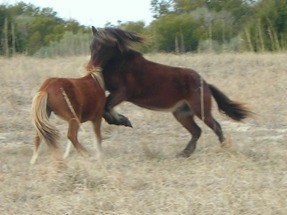|
Cape Lookout National Seashore and the Foundation for Shackleford Horses, Inc. work together to maintain a herd of wild horses on Shackleford Banks. Visitors come from near and far to discover these magnificent animals. While grazing in the grasslands or on the dunes, these horses have a tranquil appearance that contrasts sharply with the blood-quickening sight of them streaming over the dunes at full gallop, manes and tails flying. For a quick guide to horse watching at Cape Lookout National Seashore or the nearby Rachel Carson Reserve, please download Protecting Our Local Wild Horses (pdf, 113 Kb). 
NPS Photo/Brit Brown The first challenge is to find the horses. Sometimes, you arrive on the island and there are horses grazing right in front of you. At other times, you will have to go looking for them. If you don't see any horses, take along your water, bug repellent, and binoculars or camera with zoom lens. Look for a narrow path through sand, this is often a trail cut by the horses. Follow a horse path until you come to a higher area, but remember to preserve the dune vegetation—it holds the dunes in place and is an important source of food for the horses. Use existing trails and bare sand when possible. When climbing dunes, walk diagonally and avoid disturbing the sea oats. From the top of a dune or another high area, you can use binoculars to scout for horses. You may also want to look for freshwater or rainwater ponds. The ranges of harems often overlap at valuable resources like water and good grazing. But, make sure you are not so close that horses must move to other watering holes, using valuable energy. Approach with all your senses working; be ready to stop or back up. Horses have evolved to be cautious and flighty at water because their natural predators (which don't live on Shackleford) would prey on them there. The safest way to watch horses is to position yourself in such a way that you can see the entire harem--the stallion, his mares, and their foals--at one glance. If you can't be certain that you see the whole group, give them more room. 
Additional Horse Watching Tips
Remember that the horses are wild. They must find their own food and water and protect themselves from danger. Wild horses see humans and dogs as something dangerous. If you get too close to the horses they may defend themselves by charging, kicking or biting. Any time we cause a horse to move away from us that horse loses valuable grazing time. While one visitor might not consider that he or she is making a difference, the impact of hundreds of visitor a day is significant. For information on ranger-guided horse watching tours, visit the Horse Sense and Survival Tours page. For more information on the horse herd, visit the Wild Horses page. |
Last updated: October 20, 2023
